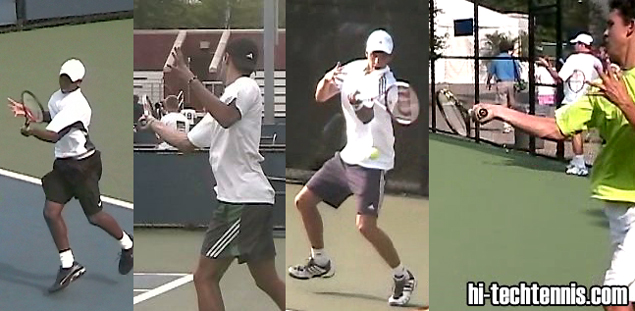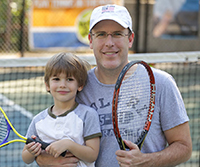The Forehand:
A Spring EventPart 2
By Jeff Counts
In my last article, "The Forehand: A Spring Event", I suggested that the visual illusion of professional forehands as whippy and wristy and immediately coming across the body has led many instructors and tennis commentators to mistakenly conclude that "racket head speed" is the big secret to power and spin in top level forehands.
In one of the "tornado cam" clips of Roger Federer that are floating around the interent, we see him pulling the butt of the racket towards the ball, and John McEnroe comments that "you can already see how fast his racket is traveling". The problem here is the implication that the racket is all that matters. Just measure the speed of this one object and you know how big the forehand is. This leads kids to try to swing as fast as they can in an attempt to get the most velocity possible into the racket head.
In "The Forehand: A Spring Event", I suggested that the physics of tennis works in a much subtler way. It's more complicated than the "speed of racket = speed of shot" formula. The physical reality of tennis is that we have a squishy, compressable tennis ball pushing into tension wound strings. Both objects merge and fully compress into each other on contact. Then the ball rebounds away in what looks like a small trampoline effect. On "tornado cam" footage we can see the amazing merging of ball and racket, and subsequent spring off of the racket. Even in my 60fps footage I sometimes capture the ball completely squashed and compressed into the strings, pushing the strings a bit backwards before it catapaults away. It is the quality of this energy exchange that really separates top level forehands from lesser skilled players. And this is why pro players will often remark on how "cleanly" they are striking the ball. The key to maximizing this energy exchange is the set up and positioning of the hitting arm, the so-called double-bend hitting structure.
 |
In professional forehands, you don't see a fast racket whipping through contact. Instead you see the racket hold back as the racket, arm, and shoulder work together through contact. |
Professional technique maximizes this springy transfer of energy between strings and ball. It allows your entire racket, hand, arm and shoulder to absorb and launch the ball. And this is exactly why we don't see rackets whipping across as quickly as many people belieive. In fact it's the opposite. The pros hold the racket in position in relation to the rest of the hitting arm as they push and lift the entire "double ben" through the ball. The crucial difference, in my opinion, between professional forehands and less skilled players is that lesser players break down this structure, often on purpose without recognizing the consequences. I often marvel at how players will try to use their elbows or wrists believing they can get extra speed. I think this llast second snapping and jerking can lead to injury. But in terms of the quality of the shot, it breaks down the structure that would allow proper compression/spring to take place.
The trick, isn't in finding a way to generate more racket head speed. It's the opposite. It involves figuring out how to hold the proper structure together through contact, so that spring is maximized. If you do this, racket head speed will take care of itself and you will hit the ball a ton, seemingly effortlessly. To do this means figuring out how (and when) the pros create the double bend structure, and how they maintain its integrity during the critical moments in the stroke.
Let's start by looking at when the pros first get into the double bend structure. On the left, you can see how all three pros (Federer, Safin, and Donald Young) have locked into the double bend at the top of their takebacks. Their upper arms and forearms form a 45 degree angle. Their wrists are laid back about 45 degrees to their forearms, forming the second "bend" in the double bend.
This early lock-in is a hallmark of professional technique. Club players rarely lock into the double bend this early (if they do at all). I encourage you to scan through the Stroke Archive and see for yourself how the pros almost always lock in behind and above their bodies.
Now that the double bend has been established above and behind the body, pro technique requires you keep this structure intact up to contact. To do this, the pros first lower the entire double bend almost straight down and then pull the racket, butt first, out towards the ball. Rather than "swing" at the ball, which usually results in jerky wrist and elbow movements, the pros lower and pull the entire double bend in order to move to contact without breaking down the structure. Let's see how Federer, Safin, and Young lower the entire double bend behind their bodies.
Notice how all three players lower the double bend as a unit. Notice as well how the racket stays tilted upward above the hand as they drop the double bend down. A common mistake is to let your elbow and/or wrist drop below the ball. Don't do this. Keep the unit intact by lowering the double bend with the hand tilted just slightly upward and the elbow at a fixed angle. Also make sure to drop the double bend almost straight down behind your hip. This will give you distance to pull the double bend toward the ball.
Now that the double bend is behind your hip with the racket butt pointed out to the ball, you can pull the racket towards the ball. This pulling motion feels very different than "swinging" the racket. It is not fast or whippy. The elbow is locked in, the wrist is stable, and you simply pull the double bend forward (and rotate your shoulders) into contact.
The goal here is NOT to generate racket head speed. The goal is meet the ball in front of the body with the double bend fully intact. You can clearly see in all three forehands below just how perfectly the pros align the double bend to the ball on contact. They have resisted all urge to swing and snap and whip, and instead have perfectly aligned their double bend unit to the ball in front of their bodies. The payoff is that on contact they have the support of their hands, arm, and shoulder to drive and lift the ball.
Let's look at how favorite player to study, David Nalbandian, is able
to have his racket, arm, and shoulder align properly on the ball at impact.
Looking at Nalbandian, we see all the hallmarks of a professional forehand.
He establishes the double bend structure early on behind and above his body. This structure
is maintained all the way to contact by lowering and then pulling, rather than swinging.
And on contact he gets a lot of mass into the ball by meeting the ball with the hand,
arm, and shoulder solidly behind the contact point.
Through contact, I want you to see how the racket, the hand, and the elbow
all lift up and push forward together. Everything is working together on contact. The
racket is not the driving force of the ball, but is more of a connector between body
and ball. The racket actually holds back to absorb the ball while the body transfers
energy into the ball by spring up and out (see my previous article).
Nalbandian starts to form the double bend above and behind his body. |
Nalbandian lowers the entire double bend as a unit. |
Nalbandian pulls the racket towards the ball, butt cap first, and turns his shoulders. |
On contact, his racket, hand, forearm, arm, and shoulder work together to transfer energy from the strings to the ball. |
The double bend structure forms the backbone of professional forehands. But as with any aspect of the strokes in a sport as dynamic and fast moving as tennis, we shouldn't take the concept so far as to think of it as rigid or stiff. There is definitely room for play in the structure, including the movement of the wrist. It's when the movement destroys the overall shape that the problems set in. While the angle of the elbow appears to stay quite constant from takeback through contact, the wrist can "relax" or "flex." But this is very different than a conscious snap or contraction. The issue is complex and varies with the specific ball, something worthy of an additional article in and of itself.
But I hope the concepts presented here and these video clips have made you at least think twice about our fascination with racket head speed and wrist movement. I have tried, in a sense, to pull our lens backwards and get a sense of the entire body racket relationship in the professional forehand. What emerges, I think, is a great respect for the pros ability to align the hand, arm, shoulder, and racket together with the ball on contact correctly every single time. It's a testimony to their ability to get their rackets and bodies to work together to transfer energy into the ball. This is what impresses me most about professional forehands.
I encourage you to experiment with swinging less and aligning more. Get a sense of how the racket and body work together on contact to create maximum energy exchange between the ball and strings. This, I think, is where you will find the biggest source of power. It's the same place the pros find it.




